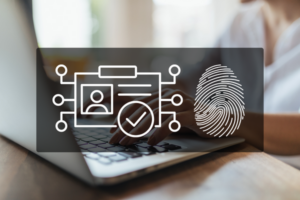
Identity crisis: Will a new national ID be better for you?
Last updated on October 9th, 2023
We have all endured the tedious task of paperwork to prove our identity, whether it is opening a new bank account, applying for a passport, or simply registering a child's birth.
Even the rise of online forms doesn’t seem to have reduced the number of times we have to fill out details to show we are who say we are.
This is likely to change in the near future, with Federal Finance Minister Katy Gallagher revealing a new digital verification service could be up and running within the next year.
The timeline seems ambitious, given there is likely to be strong opposition to a centralised database. But the aim is to give Australians a safe, government-regulated platform to store all their personal identification, such as driver’s licence, birth certificate and passport details.
So why do we need it and how will it work?
What is a national digital identity?
When you hear "ID", you might instinctively think of a physical card or a specific number. However, the national digital identity is more than just these traditional concepts.
A national digital identity is essentially a secure, easy way to prove who you are online. It’s a digital space, like myGovID, where you can store all your identification documents, such as driver's licence and passport, on a government-controlled platform. Various organisations can then securely access this platform to verify your identity online, making the whole process simpler and reducing the need for multiple documents.

This isn’t the first time Australia has tried to simplify identity verification. In the 1980s, the government wanted to introduce the Australia Card policy to give every Australian a single identification card. However, due to concerns over privacy and potential misuse, the idea was abandoned.
How is the new national digital ID different?
The new national digital ID represents a modern approach to identity verification tailored to the digital age. Here’s what sets it apart:
-
- Unlike the Australia Card, which requires a physical card, the national digital ID is digital. It's designed to provide Australians with a verified online login, eliminating the need for physical cards or multiple paper documents.
- While the Australia Card was primarily focused on tax and welfare, the national digital ID aims to be a universal login for both government and potentially private sector services, streamlining interactions across multiple platforms.
- Also, whereas the Australia Card was to be mandated, the new initiative will be optional.
Countries that already have a national digital identity
The concept of a national digital identity is not unique to Australia. Several countries, including India, Nigeria, Brazil and Estonia, have already implemented such a system.
Interestingly, the trend of adopting digital identity systems is more pronounced in developing countries. A primary driving force is the pressing need to bridge the identity gap. Many developing nations have large segments of their populations without formal identification, hindering their access to essential services, from healthcare to banking. A digital identity system serves as a powerful tool to mitigate this issue.
Additionally, developing countries often have the advantage of technological flexibility. Unlike developed nations, which might have entrenched bureaucratic systems, developing countries can more readily adopt and integrate new technologies.
What national digital identity already exists in Australia?
Australia is no stranger to the concept of digital identity. A few initiatives are already in place to verify our identity and access services more seamlessly.
At the forefront is myGovID. This app serves as a digital identity verifier. Unlike traditional physical forms of identification, myGovID is a digital solution that allows you to prove who you are online.
Australia Post has also introduced its digital identity solution, Digital iD™. This platform allows you to verify your identity once and then use that verification across multiple services, such as passport and driving licence, eliminating the redundancy of repetitive identity verification for different services.
Global financial giant MasterCard has also shown interest in Australia's digital identity space. Recognising the importance of secure online transactions, MasterCard has been exploring solutions that ensure transactional security and provide users with a seamless digital identity verification process.
Why do we need a national digital ID?
The primary reason for a national digital ID is that the existing model of identity verification, which relies on multiple physical documents and manual processes, is cumbersome, time-consuming and increasingly archaic.
In the current system, tasks like opening a bank account or accessing government services require you to present several forms of identification, such as a birth certificate, driver's licence, and utility bills. Each of these documents needs to be verified by a human, leading to potential errors, longer wait times, and inefficiencies.

There is also the risk of physical documents being lost, stolen, or forged, leading to stolen identities. Or there could be a mix-up of identities, especially if your name is similar to others, like what happened to Handle My Complaint client Jessica Meyer.
Introducing a national digital ID system offers a more streamlined solution, aligning with the digital-first approach of today's world. It will be easier for you to do almost everything, from registering a baby to enrolling to vote.
What are the pros of national digital identity?
Besides the streamlined process, the proposed national digital identity system promises a slew of benefits not only to individual users but also to businesses, government agencies, and the broader community. Here are some of them:
Enhanced security
Recent high-profile data breaches involving companies such as Optus and Medibank have highlighted the vulnerabilities of current systems. A national digital ID, fortified by state-of-the-art encryption and authentication mechanisms – such as biometrics, encryption, and other advanced security measures – offers a more secure alternative, providing better protection against such breaches and potential identity theft.
Quick and efficient access
With a national digital ID, you can access services from government benefits to employment opportunities faster and more efficiently.
A national digital ID can also be designed to be interoperable with systems in other countries, paving the way for seamless global transactions and verifications.
Data minimisation and control
A national digital ID should empower you with selective data sharing, ensuring that only pertinent information is disclosed during verification. This minimises overexposure of your personal data. Also, digital identity platforms can offer greater transparency over how your data is used. With appropriate controls in place, you can decide who gets access to your information and for what purpose. And with selective sharing, you can enhance your privacy and reduce the risk of data breaches.
Inclusivity and accessibility
A national digital ID ensures that all Australians, irrespective of their socio-economic background or geographical location, have equal access to essential services. It can be particularly beneficial if you lack traditional identification documents.
Economic and bureaucratic efficiency
A unified digital ID system can consolidate multiple identification processes into one, reducing the need for various departments or services to maintain separate identity verification systems. Also, physical documentation involves printing, storage, distribution, and manual verification – all of which incur costs. Governments and businesses can significantly reduce these overheads by transitioning to a digital strategy.
What are the cons of a national digital identity?
While a national digital identity brings many benefits, it also comes with its fair share of drawbacks to consider:
Concentration of data
A centralised digital identity system means a vast amount of personal data is stored in a single location or system. This concentration can make it a prime target for cybercriminals and hackers. A successful breach could have wide-reaching implications, given the volume and sensitivity of the data stored.
Security risks
The security of the system is only as good as its weakest link. If protections aren't robust and up-to-date, there's a risk of data breaches. As technology evolves, so do the tactics of cybercriminals. The government needs to be vigilant, ensuring regular updates and monitoring to defend against new threats that emerge.
Privacy concerns
With so much personal information in one place, there are valid concerns about how this data might be used, accessed, or potentially misused. Even with the best intentions, there's a risk of unauthorised access or data sharing, leading to potential invasions of privacy.
Inaccurate information
Digital systems, like any other, are susceptible to errors. Inaccurate information within the digital ID system can lead to a range of issues, from denial of services to legal complications. It raises the question of how the government will correct inaccuracies without it being a lengthy process.
Which agency would have oversight over the national digital identity?
Given the critical risks inherent in managing and protecting a national digital identity system, the government is aiming to put in place a robust oversight mechanism.
The Australian Competition and Consumer Commission (ACCC), with its mandate to protect consumer rights and ensure fair competition, would likely play a pivotal role in overseeing this system. It will ensure that the digital ID system operates transparently and fairly, safeguarding the interests of Australian citizens.

However, given the multifaceted nature of a digital identity system, which spans across technology, security, privacy, and consumer rights, a specific digital regulator might be needed. This regulator would focus solely on the nuances of the digital identity system and other digital transactions, ensuring its smooth operation, security, and compliance with all relevant laws and regulations.
To ensure the security and protection of the digital ID, the government should and likely will implement stringent cybersecurity measures, including:
-
- Advanced encryption techniques
- Regular security audits
- Real-time threat monitoring
Concurrently, it should establish legal frameworks to dictate how data is accessed, stored, and shared, ensuring the privacy and rights of individuals are always at the forefront.
What happens next
The government aims to launch this initiative by mid-2024, though it faces significant opposition. The Finance Minister warns that conspiracy theories are likely to emerge, disrupting implementation.
The scope of the digital ID scheme has already sparked varying opinions and disagreements. Chris McLaren, Queensland's Chief Customer and Digital Officer, has voiced concerns about an overreaching ID controlled by the Commonwealth, suggesting a more decentralised approach.
In addition, integrating various Australian digital ID schemes into a cohesive ecosystem can be challenging. Currently, there are private digital ID providers, the myGov platform, and other state-specific systems such as the NSW Digital ID. Ensuring these systems work seamlessly together will be crucial.
If you’d like to provide feedback or opinions on the matter, Have Your Say. The government invites your input on the upcoming legislation, encompassing the Digital ID Bill and its associated rules. You can:
-
- Take a brief survey, which also offers a section for detailed comments.
- Submit your insights on the Digital ID Bill and Digital ID Rules.
- Provide feedback specifically for the Digital ID Accreditation Rules.
A national digital ID seems almost inevitable. We are in an era where we regularly exchange information online and expect this process to be easier rather than harder. Being able to access all important documentation in one secure platform has huge advantages. However, legislation must be robust to ensure Australians are confident about using it.
If you are concerned you might have been the victim of identity theft, lodge a complaint with us, and we’ll help you handle it.






